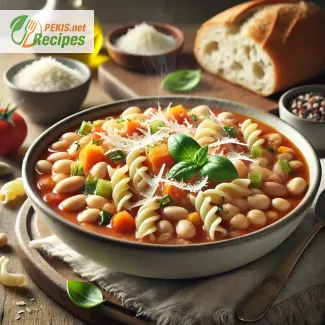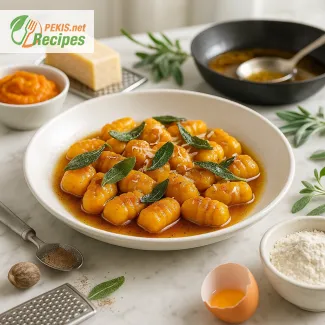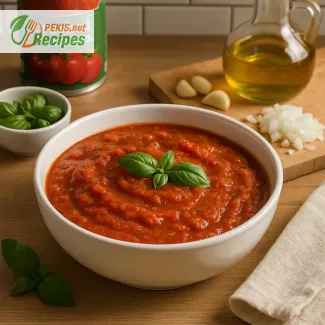
The Comforting Delight of Traditional Pasta e Fagioli
A Dish Rooted in Italian Heritage
Few dishes embody the warmth, history, and soul of Italian cuisine quite like Pasta e Fagioli. This classic Italian bean and pasta soup is a beautiful representation of how simple, wholesome ingredients can transform into a dish brimming with richness, depth, and comfort. Originating from the humble kitchens of rural Italy, Pasta e Fagioli is a time-honored dish that has evolved over centuries, cherished by families for its nourishing and satisfying qualities.
Unlike many elaborate Italian dishes, Pasta e Fagioli is a humble, rustic meal, originally crafted as an affordable and nutritious staple for hardworking farmers. It embraces the essence of Italian home cooking—utilizing readily available ingredients like beans, pasta, tomatoes, garlic, and aromatic herbs to create a flavorful, hearty dish that warms both the body and soul.
A Harmony of Flavors and Textures
At its core, Pasta e Fagioli is a delightful marriage of textures and flavors. The creamy, tender beans blend seamlessly with the perfectly cooked pasta, all enveloped in a savory, tomato-infused broth that is both rich and deeply satisfying. Every spoonful carries an explosion of taste—the sweetness of slow-cooked tomatoes, the earthiness of aromatic herbs, the silkiness of extra virgin olive oil, and the mild nuttiness of cannellini or borlotti beans.
The key to achieving the perfect balance in this dish lies in the careful selection and preparation of ingredients. Cooking the beans to the right level of tenderness, choosing the ideal pasta shape (like ditalini or tubetti), and allowing the flavors to meld slowly over low heat are all crucial steps in creating an authentic and unforgettable version of this dish.
Why Pasta e Fagioli is More Than Just a Soup
While often classified as a soup, Pasta e Fagioli offers much more than a simple bowl of broth with beans and pasta. The natural starch from the pasta thickens the broth, giving it a silky, velvety consistency that makes it more substantial than a typical soup yet lighter than a stew. This unique characteristic allows the dish to be enjoyed as both a hearty main course and a comforting side dish.
One of the most appealing aspects of Pasta e Fagioli is its versatility. Traditionally, it is a meat-free dish, making it a staple of vegetarian and Mediterranean diets. However, in different regions of Italy, variations of the recipe include pancetta, Italian sausage, or even a touch of smoky prosciutto, adding a new dimension to the depth of flavor.
For those who enjoy experimenting, adjusting the consistency of the dish is another way to tailor it to your preference. Some regions prefer a thicker, almost stew-like version, while others opt for a brothier, soup-style Pasta e Fagioli. The beauty of this dish lies in its ability to be customized while still maintaining its authentic Italian roots.
The Importance of Quality Ingredients
As with any traditional Italian recipe, the success of Pasta e Fagioli depends on the quality of its ingredients. Using fresh, ripe tomatoes, a good-quality extra virgin olive oil, and properly cooked beans makes all the difference in achieving an authentic, rich, and deep flavor.
- Beans: Cannellini or borlotti beans are the most commonly used, providing a creamy yet hearty texture. Dried beans, when soaked and cooked properly, offer a superior depth of flavor compared to canned versions.
- Pasta: Smaller pasta shapes, like ditalini or tubetti, work best as they absorb the flavors while maintaining their pleasant bite. Cooking the pasta directly in the soup allows it to soak up all the aromatic goodness of the broth.
- Tomatoes: Depending on the region, some recipes call for fresh, peeled tomatoes, while others use tomato purée or crushed tomatoes for a richer base.
- Aromatics: Garlic, onion, celery, and carrots are essential for building the depth of flavor. These ingredients are slowly sautéed in olive oil before adding the other components, ensuring a more complex, layered taste.
- Herbs and Spices: Fresh rosemary, thyme, basil, and bay leaves provide an unmistakable Mediterranean aroma. A touch of black pepper or red chili flakes adds just the right amount of warmth and complexity.
A Dish for All Seasons
One of the reasons Pasta e Fagioli has stood the test of time is its ability to adapt to different seasons and occasions. Whether served steaming hot on a chilly winter evening or at room temperature on a warm summer afternoon, it never fails to provide comfort and satisfaction.
During the colder months, serving it with a generous sprinkle of grated Parmesan cheese and a drizzle of extra virgin olive oil enhances its richness and depth. In contrast, in the warmer months, it can be made lighter and fresher by using more broth and adding a handful of fresh basil before serving.
For those who love a crunchy contrast, serving Pasta e Fagioli with a slice of toasted rustic bread or crispy ciabatta creates a perfect balance between creamy and crispy textures.
A Timeless Classic Worth Sharing
In Italian homes, Pasta e Fagioli is more than just food—it is a symbol of togetherness, tradition, and simple pleasures. Passed down through generations, it carries with it the stories and flavors of countless family meals, where laughter and conversation filled the air.
Whether you are seeking a cozy meal on a rainy day, a dish that brings back childhood memories, or a recipe that connects you to the heart of Italy, Pasta e Fagioli is a timeless classic that will always deliver.
With its irresistible aroma, hearty ingredients, and soul-warming taste, this dish is proof that some of the most comforting meals are the ones made from the simplest ingredients. Enjoy every spoonful, savor the flavors, and embrace the warmth of this beloved Italian favorite.
- Prepare the vegetables: Heat olive oil in a large pot over medium heat. Add the chopped onion, carrot, and celery. Sauté for 5 minutes until softened.
- Add garlic and herbs: Stir in the minced garlic, thyme, and rosemary, and cook for 1 minute until fragrant.
- Incorporate tomato purée: Pour in the tomato purée and cook for 2 minutes, allowing the flavors to deepen. Then, add the vegetable broth and bring to a gentle simmer.
- Add beans and seasoning: Stir in the beans, salt, black pepper, and red paprika. Reduce the heat and let simmer for 20 minutes.
- Cook the pasta: Add the pasta directly to the soup and cook for 10–12 minutes until al dente. If the soup thickens too much, add a little extra broth or water.
- Final touch: Remove the soup from heat and let it sit for 5 minutes to allow flavors to meld together.
- Serve: Garnish with grated Parmesan (optional), fresh basil, or parsley, and serve hot.
Elevating the Classic Pasta e Fagioli – Tips for a Perfect Dish
The Essence of a True Italian Comfort Dish
Pasta e Fagioli is more than just a simple bean and pasta soup—it’s a rich, hearty, and deeply flavorful dish that embodies the soul of Italian home cooking. This rustic recipe has been passed down through generations, evolving with regional variations and personal touches. At its core, it is a dish of resourcefulness, using staple pantry ingredients to create something truly satisfying.
The beauty of Pasta e Fagioli lies in its ability to be adapted and customized to fit different palates and preferences. While the traditional version is already a well-balanced combination of beans, pasta, tomatoes, and herbs, there are many ways to enhance and elevate this dish even further. From experimenting with different types of beans and pasta to incorporating various broths, spices, and protein sources, a few small tweaks can make a significant impact on the depth of flavor and texture.
Choosing the Right Beans for the Best Texture
The choice of beans is one of the most critical elements in creating an authentic and delicious Pasta e Fagioli. The beans contribute not only to the overall heartiness of the dish but also to its texture and mouthfeel.
- Cannellini beans are the most traditional choice, offering a smooth, creamy texture that blends seamlessly into the broth.
- Borlotti beans provide a slightly firmer bite and a nuttier, richer taste, which adds an extra layer of complexity.
- Chickpeas can be used for a slightly denser texture and earthy undertone, though they will make the dish less creamy.
- Black beans or kidney beans create a more robust, protein-packed version, though they can slightly alter the traditional flavor profile.
For those who prefer a creamier, thicker broth, mashing a portion of the beans before adding them to the pot will naturally thicken the soup while keeping it wholesome and rich.
The Secret to Perfectly Cooked Pasta
One of the most common mistakes when making Pasta e Fagioli is overcooking the pasta, which can lead to a mushy texture that absorbs too much liquid. The way pasta is cooked can completely change the consistency of the dish.
- For a thicker, more stew-like version, cook the pasta directly in the soup, allowing it to soak up the flavors of the broth. However, this requires adding more liquid towards the end, as the pasta will continue to absorb moisture.
- If you prefer a looser, brothier consistency, cook the pasta separately and add it just before serving. This prevents it from becoming too soft and allows for better control over the texture.
- Using smaller pasta shapes like ditalini, tubetti, or orzo ensures that each spoonful contains the perfect ratio of pasta to broth.
For a gluten-free version, swap out traditional wheat pasta for gluten-free alternatives like rice pasta, lentil pasta, or quinoa pasta. These variations add a unique flavor and additional nutrients while keeping the dish accessible for those with dietary restrictions.
Boosting the Flavor with the Right Aromatics
The base flavors of Pasta e Fagioli come from the careful layering of aromatics, which build a deep and complex foundation for the dish. This step is crucial in achieving a well-rounded taste that isn’t simply dominated by tomatoes or beans.
- Sautéing onions, celery, and carrots in olive oil at the beginning creates a naturally sweet and aromatic base that enhances the overall richness of the dish.
- Adding garlic at just the right moment—not too early—prevents it from burning while allowing its full flavor to develop.
- A splash of dry white wine or red wine can be added during the cooking process to deepen the layers of flavor, enhancing the acidity of the tomatoes while adding complexity.
For an even bolder flavor, consider incorporating a small piece of Parmesan rind into the broth as it simmers. The rind will melt slightly, infusing the soup with a rich umami depth without overpowering it.
The Role of Tomatoes – Fresh vs. Canned
Tomatoes contribute significantly to the balance of acidity and sweetness in Pasta e Fagioli. Choosing the right type can make a noticeable difference in the richness and consistency of the soup.
- Fresh tomatoes, peeled and chopped, offer a bright and fresh acidity, perfect for those who enjoy a lighter, more summery version of the dish.
- Canned whole San Marzano tomatoes, when crushed, provide a more intense, slightly sweet tomato base that works well for a heartier winter-style soup.
- Tomato paste can be added for extra depth and a concentrated tomato flavor, especially in recipes that use vegetable broth instead of meat-based broths.
To reduce acidity, a small pinch of sugar or grated carrot can be added to balance the flavors naturally.
Incorporating Protein for a Heartier Dish
While Pasta e Fagioli is traditionally vegetarian, adding protein can create a more filling meal while enhancing the overall richness. Some delicious variations include:
- Italian sausage, browned before adding the vegetables, contributes a savory, slightly spicy depth to the broth.
- Pancetta or prosciutto adds a smoky, salty complexity that pairs beautifully with the creaminess of the beans.
- Shredded chicken or ground turkey provides a leaner alternative while keeping the dish hearty and satisfying.
For a vegan alternative, adding cooked lentils or tofu crumbles can boost the protein content while maintaining the original integrity of the dish.
Garnishing for the Perfect Presentation
The final touches on a bowl of Pasta e Fagioli are just as important as the cooking process. A well-garnished dish not only looks more appetizing but also enhances the flavor with fresh, vibrant contrasts.
- A generous sprinkle of freshly grated Parmesan cheese adds a salty, umami kick.
- A drizzle of high-quality extra virgin olive oil enhances the silkiness of the broth.
- Fresh chopped basil or parsley brightens the dish with a touch of herbal freshness.
- Red pepper flakes or a pinch of black pepper can be added for those who prefer a hint of heat.
Serving Suggestions and Pairings
To truly elevate the dining experience, consider serving Pasta e Fagioli with:
- Crusty Italian bread or ciabatta, perfect for soaking up the flavorful broth.
- A side of roasted vegetables like zucchini or bell peppers to add color and balance.
- A simple green salad with a lemon vinaigrette for a refreshing contrast.
- A glass of Chianti or Pinot Grigio, which pairs beautifully with the earthy and tomato-rich flavors of the dish.
A Timeless Italian Favorite
Pasta e Fagioli is more than just a traditional Italian soup—it is a dish of comfort, nourishment, and rich history. Whether enjoyed on a cold winter night or as a light summer meal, its versatility and deep, satisfying flavors make it a beloved favorite worldwide. By experimenting with ingredients, cooking techniques, and pairings, you can tailor this timeless classic to suit your personal preferences while preserving its authentic charm.
- Contains gluten (due to pasta)
- Contains dairy (if Parmesan is used)
Substitutions for Allergies and Gluten-Free Version:
- For a gluten-free version, use gluten-free pasta or rice-based pasta.
- For a vegan version, omit Parmesan or replace it with nutritional yeast.
- Vitamin A (5000 IU) – Supports eye health and skin regeneration.
- Vitamin C (25 mg) – Strengthens the immune system and enhances iron absorption.
- Calcium (150 mg) – Essential for strong bones and teeth.
- Iron (4 mg) – Helps in red blood cell formation and prevents anemia.
- Magnesium (60 mg) – Supports muscle function and nervous system health.
- Lycopene (3 mg) – Found in tomatoes, protects cells from oxidative stress.
- Flavonoids (2 mg) – Present in beans and vegetables, support heart health.
- Beta-carotene (1.5 mg) – From carrots, enhances skin and vision health.
- Polyphenols (5 mg) – Have anti-inflammatory properties and support digestion.





